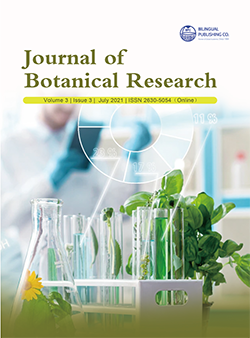-
28845
-
17504
-
3260
-
1194
-
1168
Proteomics and Bioinformatics as Novel Tools in Phytoremediation Technology- An Overview
DOI:
https://doi.org/10.30564/jbr.v3i3.3380Abstract
Biotechnology plays an important role in mitigation of various pollution in a cost effective manner by using the complex chemistry of living organisms, various cell manipulations and their approaches for environmental cleanup along with environmental sustainability. One such technology is phytoremediation technology or green technology which has emerged and evolved as a novel tool for remediation of toxic contaminants from environment. Plants with its diverse range show a remarkable range of their phytoremediation potentiality for establishing a sustainable environment. There is a huge exploitation of natural resources through expanded industrialization, urbanization, modern agricultural development, energy generation to fulfill the never-ending human desires and need. This disturbs the balance in nature where we reside and leads to progressive deterioration of the environment. There are several biotechnological advances which are employed for combating both the biotic and abiotic stress problems caused due to toxic contaminants in the environment. Various biotechnological interventions such as bioinformatics, proteomics, genomics, metallomics and metabolomics play a crucial role and open new avenue in this context. This omics approach is now integrated with bioinformatics to serve as a novel tool in phytoremediation technology. This smart technology provides insights into the complex behavior of enzymes, proteins and metabolites action and their biochemical pathways for degradation of wastes. This leads towards deriving a sustainable solution for environmental pollution.
Keywords:
Bioinformatics, Proteomics, Genomics, Phytoremediation, Transgenic plantsReferences
[1] Mohanty M. (2016), ‘Post-Harvest Management of Phytoremediation Technology”, J Environ Anal Toxicol, 2016, 6:5, 1-8.
[2] Zhang, C, Bennett GN (2005), “Biodegradation of xenobiotics by anaerobic bacteria”, Appl Microbiol Biotechnol, 67: 600-618.
[3] Samanta, SK., Singh, O.V. and Jain, R.K. (2002), “Polycyclic aromatic hydrocarbons: environmental pollution and bioremediation”, Trends Biotechnol, 20: 243-248.
[4] Fulekar, M. H., & Jaya, S. (2008), “Bioinformatics for bioremediation”, Innovative Romanian Food Biotechnology, 2(2)28-36.
[5] Coleman, J. O., Haslam, R. P., & Downie, A. L. (2005), “Transcriptomics and proteomics: Tools for optimising phytoremediation activities”, Zeitschrift für Naturforschung C, 60(7-8), 544-548.
[6] Leung M (2004), “Bioremediation: techniques for cleaning up a mess”, J Biotechnol, 2:18-22.
[7] Wojas S, Hennig J, Plaza S, Geisler M, Siemianowski O et al (2009), “Ectopic expression of Arabidopsis ABC transporter MRP7 modifies cadmium root-toshoot transport and accumulation”, Environ Pollut, 157(10):2781-2789.
[8] Singh. JS, Abhilash PC, Singh HB, Singh RP, Singh DP (2011), “Genetically engineered bacteria: an emerging tool for environmental remediation and future research perspectives” Gene, 480:1-9.
[9] Dhankher OP, Doty SL, Meagher RB, Pilon-Smits E (2011), “Biotechnological approaches for phytoremediation”, In: Altman A, Hasegawa PM (eds) Plant biotechnology and agriculture. Academic Press, Oxford, pp 309-328.
[10] Kumar C, Mani D (2012), “Advances in bioremediation of heavy m(etals: a tool for environmental restoration”, LAP LAMBERT Academic Publishing A)-G & Co. KG, Saarbru¨cken.
[11] Mani D, Kumar, C. (2014), “Biotechnological advances in bioremediation of heavy metals contaminated ecosystems: an overview with special reference to phytoremediation”, Int. J. Environ. Sci. Technol, 11:843-872.
[12] Lyyra S, Meagher RB, Kim T, Heaton A et al (2007), “Coupling two mercury resistance genes in Eastern cottonwood enhances the processing of organomercury”, Plant Biotechnol J, 5:254-262.
[13] Bañuelos, G., Terry, N., LeDuc, D. L., Pilon-Smits, E. A., & Mackey, B. (2005), “Field trial of transgenic Indian mustard plants shows enhanced phytoremediation of selenium-contaminated sediment”, Env. Sci. & Techn., 39(6), 1771-1777.
[14] Poirier I, Hammann P, Kuhn L, Bertrand M (2013), “Strategies developed by the marine bacterium Pseudomonas fluorescens BA3SM1 to resist metals: a proteome analysis”, Aquat Toxicol, 128(129), 215- 232.
[15] Bell TH, Joly S, Pitre FE , and Yergeau E (2014), “Increasing phytoremediation efficiency and reliability using novel omics approaches”, Trends in Biotech, 32, (5), 271-280.
[16] Khan N.T.(2018), “Integration of Bioinformatics in Bioremediation”, Int J Biomed Data Min 7, 1000130. DOI: 10.4172/2090-4924.1000130.
[17] Pollard AJ, Powell KD, Harper FA, Smith JAC (2002), “The genetic basis of metal hyperaccumulation in plants”, Crit. Rev. Plant Sci, 21,539-566.
[18] Papoyan A, Kochian LV (2004), “Identification of Thlaspi caerulescens genes that may be involved in heavy metal hyperaccumulation and tolerance-Characterization of a novel heavy metal transporting ATPase”. Plant Physiol, 136, 3814-3823.
[19] Weber M, Harada E, Vess C, von Roepenack-Lahaye E, Clemens S (2004), “Comparative microarray analysis of Arabidopsis thaliana and Arabidopsis halleri roots identifies nicotianamine synthase, a ZIP transporter and other genes as potential metal hyperaccumulation factors”, Plant J, 37,269-281.
[20] Gratão, P. L., Prasad, M. N. V., Cardoso, P. F., Lea, P. J., & Azevedo, R. A. (2005), “Phytoremediation: green technology for the cleanup of toxic metals in the environment”, Braz J Plant Physiol, 17(1), 53-64.
[21] Chiapello, M., Perotto, S., & Balestrini, R. (2015), “Symbiotic Proteomics—State of the art in plant-mycorrhizal fungi interactions”, Recent Adv in Proteomics Res, 10, 61331.
[22] Martins, I.J. (2016) Anti-Aging Genes Improve Appetite Regulation and Reverse Cell Senescence and Apoptosis in Global Populations. Advances in Aging Research, 5, 9-26.




 Monalisa Mohanty
Monalisa Mohanty





